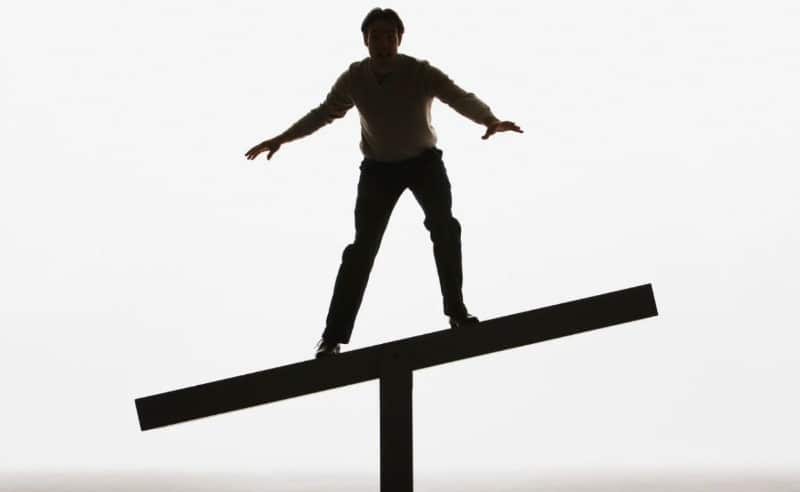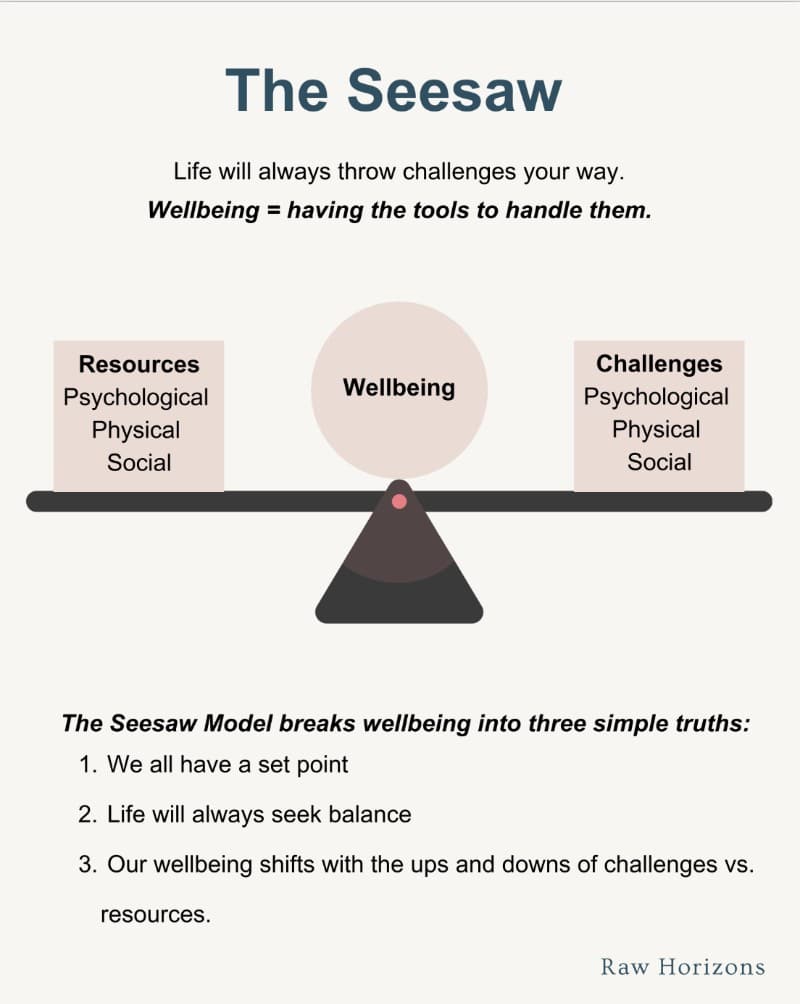Why Your Wellbeing Works Like a Seesaw (And Why That’s Actually Good News)
A client once described her experience of life as feeling like she was constantly being knocked off balance. “Just when I think I’m managing,” she said, “something else comes along and tips everything over again.”
I could hear the exhaustion in her voice. The sense that wellbeing was something elusive she was supposed to achieve and maintain, and that she was somehow failing because she couldn’t stay there.
But here’s what I’ve come to understand through years of coaching: that’s not how wellbeing works. And expecting it to is setting ourselves up for disappointment.
What if, instead of thinking about wellbeing as a fixed state we need to reach and maintain, we understood it as something inherently dynamic? Something that’s always in motion, always shifting, and that this movement is not only normal but necessary?
This is where a different framework becomes helpful. One that acknowledges the reality of how we actually experience life rather than prescribing how we think we should feel.
At Raw Horizons, we call it the Seesaw Model of wellbeing. It’s beautifully simple, yet it changes everything about how we approach mental and emotional health.
Picture a seesaw – the kind you might have played on as a child. On one side sit life’s challenges: stress, uncertainty, change, loss, conflict, and responsibility. On the other side sit your resources: inner strength, self-awareness, support systems, coping strategies, resilience.
The seesaw is always in motion. Always shifting. And that’s not a problem to be solved… It’s simply how life works.
The model centres around three key concepts:
A set point for wellbeing that we return to. Everyone has a baseline – their natural equilibrium. It’s not about being happy all the time or never experiencing difficulty. It’s about having a centre of gravity that you tend to return to.
The natural drive toward equilibrium. Just like a seesaw eventually settles, we have an innate tendency to seek balance. Our minds and bodies are constantly working to restore equilibrium, even when we’re not consciously aware of it.
A constant shift between challenges and resources. The seesaw never stops moving. New challenges arrive. Resources grow or temporarily deplete. This dynamic movement is the nature of being alive.
Why We Struggle With the Seesaw
Many of us have absorbed the idea that wellbeing is a destination. We think we’re supposed to “get there” and stay there – permanently calm, consistently happy, perpetually balanced.
So when life tips the seesaw and we feel stressed, anxious, or overwhelmed, we interpret it as failure. We think something’s wrong with us. We believe we’ve lost our wellbeing rather than understanding that we’re simply in a moment of natural imbalance.
This belief creates additional suffering. Not only are we dealing with whatever challenge landed on our seesaw, but we’re also berating ourselves for not being “well” enough to handle it effortlessly.
I’ve noticed this particularly with clients who are high achievers. They apply the same standards to their emotional lives that they apply to their work – expecting to optimise, control, and master their wellbeing. When the seesaw tips, they see it as evidence of weakness rather than a normal part of being human.
The Weight of Challenges
Life will always bring challenges. Unfortunately, that’s just reality.
Work pressures. Relationship tensions. Health concerns. Financial worries. Unexpected changes. Loss and grief. The normal demands of caring for ourselves and others.
Some of these challenges are temporary – they land on the seesaw, tip us off balance for a while, then lift away. Others are more persistent, weighing down one side for extended periods.
What’s interesting is that it’s not always the size of the challenge that determines how much it impacts us. Sometimes, relatively small stressors can tip us significantly if we’re already depleted of resources. Other times, we surprise ourselves by handling major difficulties with more resilience than we expected.
The question isn’t whether challenges will arrive. They will. The question is: what resources do we have on the other side of the seesaw?
The Power of Resources
Resources come in many forms. Some are internal: emotional regulation, self-compassion, perspective-taking, problem-solving skills, the ability to tolerate discomfort without panicking.
Others are external: supportive relationships, financial stability, access to help, time for rest and recovery, connection to community or purpose.
Here’s what I’ve learned: most people are far more resourced than they realise. But they’ve never taken inventory. They’ve never consciously identified what’s already sitting on their side of the seesaw.
When we work together to map someone’s resources, there’s often a visible shift. “I didn’t think of that as a resource,” they’ll say, or “I forget I have that option when I’m stressed.”
The act of recognising what you already have available changes your relationship with challenges. You stop feeling powerless and start seeing possibilities.
Building Your Resource Side
The beautiful thing about the Seesaw Model is that we’re not helpless. While we can’t always control what lands on the challenge side, we can intentionally build up the resource side.
This might mean:
Developing self-awareness. Understanding your patterns, triggers, and needs means you can respond to challenges more effectively rather than being blindsided by them.
Strengthening emotional skills. Learning to name and process difficult feelings rather than suppressing or being overwhelmed by them. Building the capacity to sit with discomfort without immediately needing to fix or escape it.
Creating support systems. Identifying who you can turn to for different kinds of support. Sometimes we need practical help, sometimes we need emotional support, sometimes we just need someone to remind us we’re not alone.
Establishing healthy practices. Sleep, movement, nutrition, time in nature, creative expression, practices that help you return to centre. Not because you “should” but because you notice the difference they make to your capacity.
Building your tool-bag of strategies. Having multiple approaches available rather than relying on a single coping mechanism. What works in one situation might not work in another, so flexibility matters.
Connecting to purpose. Knowing what gives your life meaning provides context for challenges. Difficulties become obstacles in the service of something that matters rather than pointless suffering.
The key is consistency. These aren’t emergency measures we implement only when crisis hits. They’re the ongoing practices that keep resources available on our side of the seesaw.
When Balance Feels Impossible
Some seasons of life tip the seesaw more than others. Illness, loss, major life transitions, caring responsibilities, or simply the accumulation of multiple stressors can make balance feel impossible.
In these moments, wellbeing isn’t about achieving equilibrium. It’s about not tipping completely off the seesaw. It’s about finding whatever small resources you can access and using them as best you can.
Sometimes the most important resource is simply acknowledging: “This is really hard right now, and that’s okay.”
Giving yourself permission to struggle, rather than adding self-judgment to the pile of challenges, frees up energy. Accepting where you are doesn’t mean you’re giving up; it means you’re being honest about your starting point.
From there, even tiny actions matter. A five-minute walk. One phone call to a friend. Going to bed thirty minutes earlier. These aren’t going to instantly restore balance, but they’re adding small weights to your resource side.
The Everyday Practice
Understanding the Seesaw Model changes how you approach each day.
You stop expecting to feel the same all the time. You recognise that some days the seesaw will tip more than others, and that’s information, not failure.
You become more intentional about tending to your resource side. Not frantically trying to compensate when crisis hits, but steadily building capacity during ordinary times.
You notice what tips your seesaw without judgment. Instead of “I shouldn’t let this bother me,” you think “This is challenging right now. What resources do I need?”
You make decisions based on what serves your equilibrium. Not every opportunity is worth the weight it would add to your challenge side. Not every demand deserves your yes.
Most importantly, you trust the process. You remember that the seesaw has tipped before and found its way back to centre, that your natural drive toward equilibrium is always working, even when progress feels slow.
Moving Forward With the Model
If this framework resonates with you, I’d encourage you to do your own inventory.
What’s currently weighing down the challenge side of your seesaw? Be honest about what’s actually there, even if you think you “should” be handling it better.
What resources do you already have on the other side? Don’t just list the obvious ones. What strengths, skills, relationships, and practices are actually available to you?
Where are the gaps? What resources would make the most difference if you developed them?
The goal isn’t to achieve perfect balance. Remember – the seesaw is always moving. The goal is to become more skilled at navigating that movement. To build a solid foundation of resources. To develop the awareness and skills that allow you to respond to challenges with greater ease.
Because wellbeing isn’t a destination you reach and then maintain effortlessly. It’s a practice. A constant process of noticing what’s tipping your seesaw and thoughtfully adding to your resources.
And sometimes, the most important resource is having someone walk alongside you through that process.
If you’re interested in helping others find their balance and build their resources, our Health & Wellbeing Coach Training teaches you not just the theory of frameworks like the Seesaw Model, but how to apply them skilfully in supporting others.








